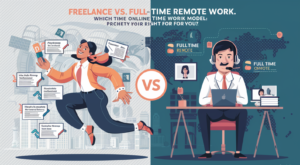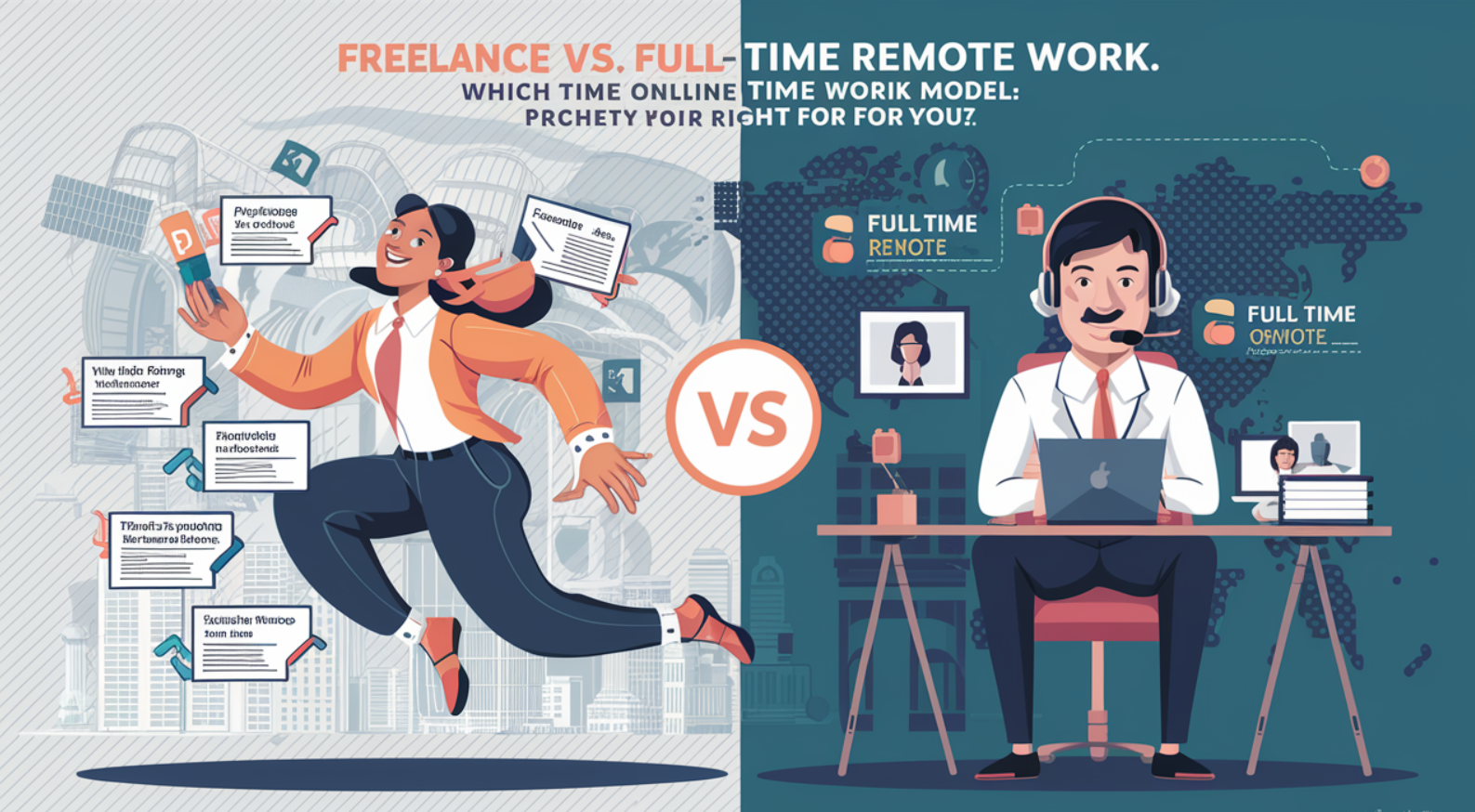Introduction
We’re no longer living in an age where 9-to-5 office jobs are the only way to make a living. In fact, millions around the world are now working from beaches, coffee shops, or their kitchen tables. Freelancing and remote work have changed the game entirely—and it’s not just a trend. It’s a whole new era of professional freedom.
So why is this so important right now? Because people are craving flexibility, balance, and autonomy. They want to do work that matters without being chained to a desk in a cubicle. Sound familiar? Let’s dig in.
Understanding the Gig Economy
What is Freelancing?
Freelancing is essentially being your own boss. You sell your services to clients on a project or contract basis. No long-term employer, no rigid schedules—just you and your craft.
The Difference Between Freelancing and Remote Work
Freelancing means being self-employed. Remote work simply means working away from the traditional office—whether you’re a full-time employee or a contractor. You can be both a remote worker and a freelancer, but they’re not always the same.
Stats and Growth Over the Last Decade
According to a recent report by Upwork, more than 60 million Americans freelanced in 2023—that’s nearly 40% of the workforce. And globally? The numbers are even bigger. It’s clear: the gig economy is booming.
The Remote Work Revolution
How the Pandemic Accelerated Remote Culture
COVID-19 didn’t start remote work, but it definitely pushed it into the spotlight. Suddenly, companies had no choice but to adapt. What they found? Remote workers were just as productive—sometimes even more.
Big Brands That Embraced It Fully
Companies like Twitter, Shopify, and Basecamp embraced remote-first models. Even giants like Google and Amazon implemented long-term hybrid strategies. Remote work isn’t a backup plan anymore—it’s becoming the default.
Hybrid Work: The In-Between Model
Not everyone wants to ditch the office completely. Hybrid models let you split your time between home and office. It’s flexible, adaptable, and ideal for folks who want the best of both worlds.
Advantages of Freelancing
Freedom and Flexibility
You pick your projects. You set your hours. You decide when to work and when to take that midweek hike. This freedom is priceless.
Earning Potential and Global Reach
Freelancers aren’t tied to one city or even one country. You can work with clients from New York to New Delhi. That means you can also set your rates and scale faster than a traditional job allows.
Diverse Opportunities Across Industries
From graphic design to virtual assistance, writing to software development—there’s something for everyone in the freelance world.
Benefits of Remote Work for Employees
Work-Life Balance Perks
No more commutes. More time with family. Remote work allows people to design their day in ways that support their health, relationships, and happiness.
Cost Savings for Workers
Think about it: no gas, no takeout lunches, no office attire. Remote workers save thousands annually.
Better Productivity in Home Environments
Studies show many people focus better at home than in noisy offices. Fewer distractions, more flow.
Benefits for Employers
Reduced Operational Costs
With fewer people in the office, businesses save big on rent, electricity, and office supplies.
Access to Global Talent
Companies can hire the best people—no matter where they live. That’s a game-changer for innovation and competitiveness.
Increased Employee Satisfaction and Retention
Happy employees stick around longer. Remote work boosts morale, which directly impacts retention rates.
Popular Freelancing Platforms
Upwork, Fiverr, Freelancer, and More
These platforms make it easy to connect with clients. Whether you’re just starting out or scaling your solo business, there’s a place for you.
Niche Platforms by Profession
Writers love Contena. Developers hang out on Toptal. Designers go to 99designs. Find your tribe!
Essential Tools for Freelancers and Remote Workers
Communication and Collaboration Tools
Slack, Zoom, Microsoft Teams—these keep everyone connected no matter the time zone.
Time Tracking and Productivity Software
Toggl, RescueTime, Clockify—great for managing projects and proving billable hours.
Financial Tools for Invoicing and Payments
Wave, PayPal, FreshBooks—get paid on time and stay financially organized.
Challenges of Freelancing and Remote Work
Isolation and Lack of Structure
Without coworkers around, things can get lonely. Plus, staying disciplined without a boss requires serious self-motivation.
Inconsistent Income
Some months are gold, others are dry. That’s the nature of the gig—budgeting becomes essential.
Work-Life Balance Struggles
Ironically, working from home can blur boundaries. Suddenly, you’re working at midnight or skipping breaks. Not ideal!
How to Succeed as a Freelancer
Building a Portfolio and Personal Brand
Your portfolio is your digital handshake. Make it strong, polished, and niche-specific.
Finding Clients and Networking
LinkedIn, online communities, referrals—it’s all about relationships. Provide value and watch your client base grow.
Setting Boundaries and Managing Time
Have office hours. Create routines. Respect your own time so others will too.
The Future of Work
Predictions and Evolving Trends
Experts predict that by 2030, freelance workers could make up the majority of the workforce. Offices? Optional. Autonomy? Expected.
The Role of AI and Automation
AI is changing the way we work—but not replacing humans. Instead, it’s helping freelancers work smarter, faster, better.
Freelancing vs. Traditional Employment
Which is Better?
That depends on you. Want stability and benefits? Go traditional. Craving freedom and variety? Freelance might be your calling.
Pros and Cons Comparison
| Freelancing | Traditional Jobs |
|---|---|
| Flexible hours | Fixed schedule |
| Unlimited earning potential | Steady paycheck |
| No job security | Job security and benefits |
| Creative freedom | Hierarchical structure |
Government and Legal Aspects
Taxes and Regulations
Freelancers are responsible for their own taxes. Depending on your country, this may include quarterly payments and self-employment tax.
Legal Protections for Freelancers
Some places are introducing laws to protect gig workers (like California’s AB5). It’s wise to understand contracts, rights, and obligations.
Case Studies of Successful Freelancers
Real-World Stories of Success
From bloggers earning six figures to designers working with Fortune 500 companies—success looks different for everyone.
Lessons Learned from the Pros
The common thread? Consistency, quality work, and excellent communication.
Conclusion
The rise of freelancing and remote work is more than a shift—it’s a movement. People are choosing freedom over rigidity, creativity over conformity. The future of work is flexible, borderless, and full of opportunity. Whether you’re just starting or already knee-deep in this new world, there’s never been a better time to take control of your career.
FAQs
Q1: Is freelancing a secure career option?
A: With the right skills, mindset, and hustle, freelancing can be both profitable and secure. But it does require self-discipline and planning.
Q2: Can remote work replace office jobs completely?
A: Not entirely. Some roles still need a physical presence, but a large portion of jobs can—and will—stay remote or hybrid.
Q3: What skills are in demand for freelancers?
A: Writing, design, programming, marketing, video editing, consulting—anything that can be done online has a place.
Q4: How do I start freelancing with no experience?
A: Start small. Build a portfolio with sample work, take on smaller gigs, and grow from there. Everyone starts somewhere.
Q5: Do freelancers get health benefits or insurance?
A: Not automatically. But many join freelancer unions or buy their own insurance through platforms like Freelancers Union.
Read more Articles about Freelancing & Remote work

